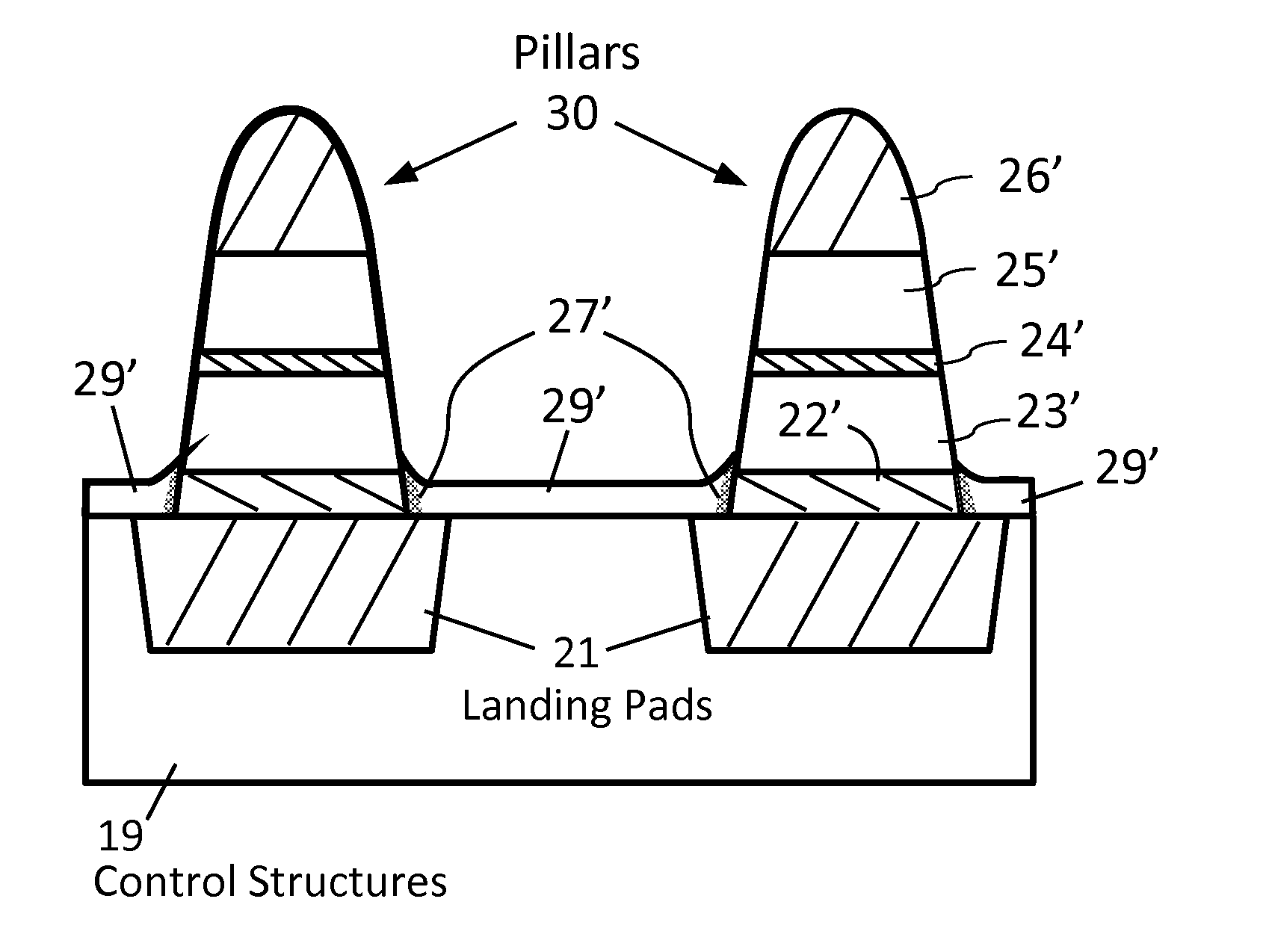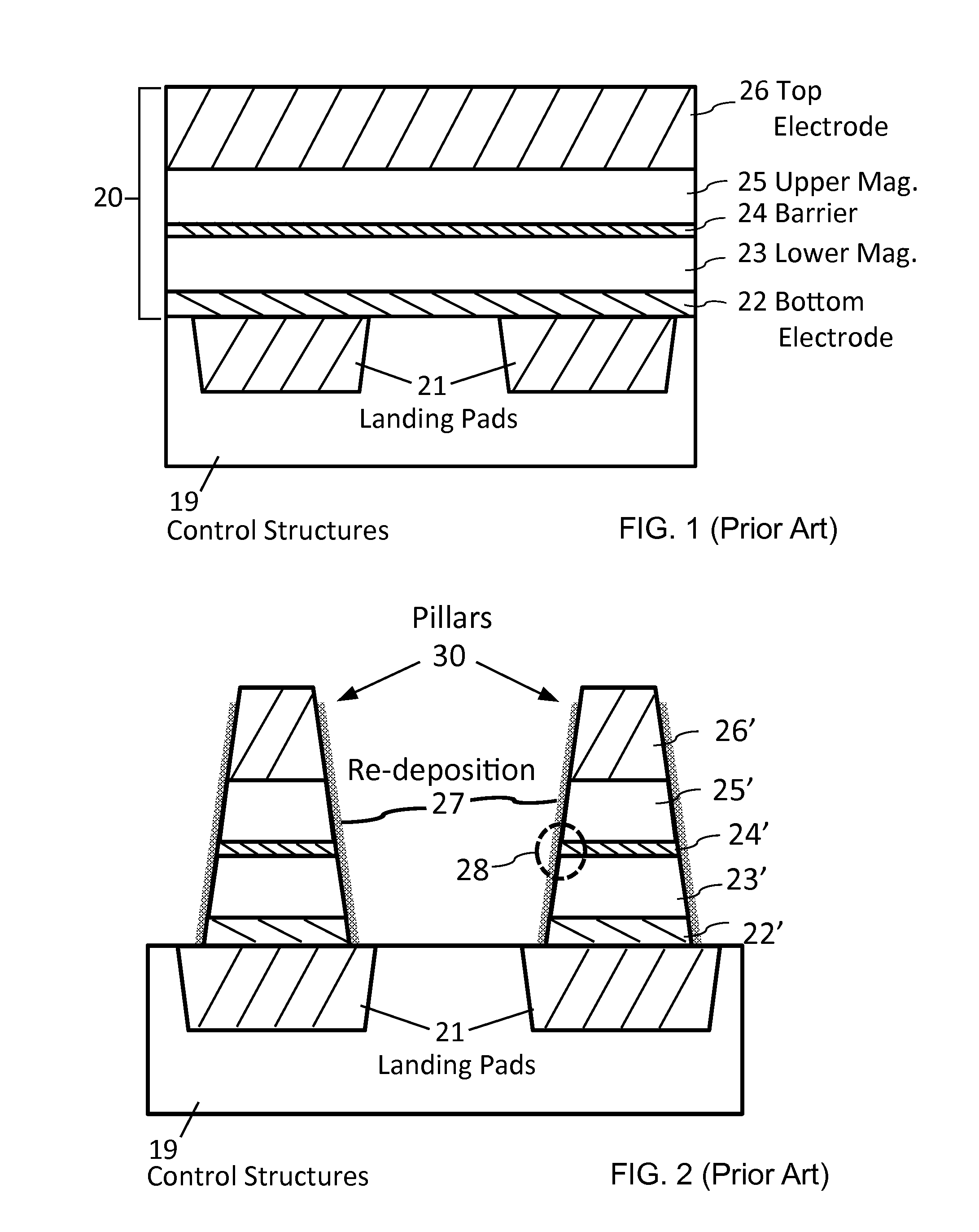MRAM Fabrication Method with Sidewall Cleaning
a fabrication method and sidewall cleaning technology, applied in the direction of magnetic field-controlled resistors, semiconductor devices, electrical devices, etc., can solve the problems of shortening defect, especially deleterious, exposed sidewalls of memory elements that are susceptible to being shorted with re-deposited metal, etc., to enhance or optimize the process
- Summary
- Abstract
- Description
- Claims
- Application Information
AI Technical Summary
Benefits of technology
Problems solved by technology
Method used
Image
Examples
first embodiment
[0027]
[0028]FIGS. 3-8 will be used to illustrate the first embodiment of the invention. The process stage in FIG. 3 follows that of FIG. 2. FIG. 3 illustrates the result of the deposition of dielectric film 29 over the pillars. The dielectric layer 29 has been formed over the MTJ pillars 30 by vertical directional deposition such as down-flow CVD or biased CVD. Accordingly the dielectric layer 29 is thicker in flat area such as the space between the pillars and is thinner on the sidewalls. The dielectric layer 29 completely covers the undesirable re-deposition material 27 and generally conforms to the existing topography of the pillars.
[0029]FIG. 4 illustrates a cross sectional view of a process stage, subsequent to that of FIG. 3, after sidewall cleaning has been performed using an etching technique that results in the top surface of the pillar being etched faster than the other surfaces which are etched isotropically. Although the dielectric material 29 on top of the pillars is th...
second embodiment
[0032]
[0033]FIGS. 9 and 10 illustrate a second embodiment of the invention which uses high density plasma CVD for sidewall cleaning. As for the first embodiment, the pillars are patterned as shown in FIG. 2. FIG. 9 shows that a relatively thick dielectric material 51 has been deposited over the pillars 30 which include metallic re-deposition material 27 on the sidewalls as described above. The dielectric material 51 is selected to be an oxygen-free material such as silicon nitride or silicon carbide. The dielectric material 51 is thinner on top of the pillars than in the valley areas between the pillars. Next a dry etching is used to etch the dielectric material 51 and re-deposition material 27. The chemistry system is selected for more rapid removal of the dielectric material 51 and slower removal of the material in the top electrode 26′. Appropriate systems include CH3OH and CO / NH3 and the like. The dielectric material 51 is vertically etched to the stage as shown in FIG. 10 and t...
third embodiment
[0034]
[0035]FIG. 11 to FIG. 13 illustrate a third embodiment of the invention that uses CMP for sidewall cleaning. The pillars are first patterned as illustrated in FIG. 2. FIG. 11 shows that a dielectric material 53 has been deposited over the pillars 30 in a relatively thin layer that roughly conforms to the topography of the pillars. The dielectric material 53 is selected to be an oxygen-free material such as silicon nitride or silicon carbide and like materials. The next part of the process is illustrated in FIG. 12 which shows that a relatively thick dielectric film 61, such as one of the silicon oxides, has been deposited and then the wafer has been planarized with CMP. Next the dielectric layers 53, 61 are vertically etched. The chemistry system is selected to have high selectivity for more rapid removal of the dielectric material 53, 61 and slower removal of the material in the top electrode 26′. Appropriate systems include CH3OH and CO / NH3 and the like.
[0036]The dielectric ...
PUM
 Login to View More
Login to View More Abstract
Description
Claims
Application Information
 Login to View More
Login to View More - R&D
- Intellectual Property
- Life Sciences
- Materials
- Tech Scout
- Unparalleled Data Quality
- Higher Quality Content
- 60% Fewer Hallucinations
Browse by: Latest US Patents, China's latest patents, Technical Efficacy Thesaurus, Application Domain, Technology Topic, Popular Technical Reports.
© 2025 PatSnap. All rights reserved.Legal|Privacy policy|Modern Slavery Act Transparency Statement|Sitemap|About US| Contact US: help@patsnap.com



